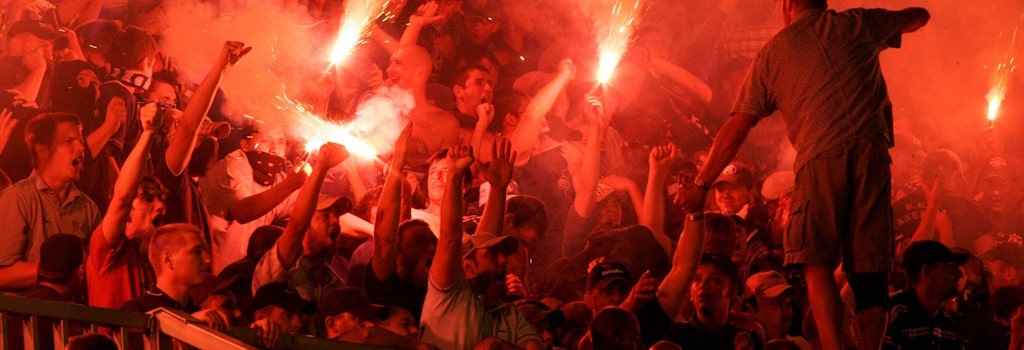

Aggressive football fans are practically a sport within the sport itself. These ultras know how to bring the noise - and often a bit of chaos - wherever they go. Sure, you might see them as passionate. But if you're on the Betway app trying to make sense of the odds, it's good to know how the crowds in the stands might actually impact the game. In Europe, several groups stand out, known for their hostility, and the unfortunate aftermath of their matches.
Galatasaray's UltrAslan ultras are like no other. Fans of the Istanbul powerhouse have a reputation for making their home turf, the Nef Stadium, feel like an inferno. They've been known to set off an endless stream of flares, blinding visitors with clouds of red smoke. This creates an atmosphere that's intimidating to players and electrifying for fans. Their spot? The north end, where they wave massive flags, let off fireworks and greet rivals with a menacing roar.
But their antics don't stop there. UltrAslan is notorious for causing scenes even outside the stadium. They'll show up en masse in places like hotels, causing sleepless nights for opposing players. Recently, their high-stakes clash with rivals Marseille in the UCL saw them shower the visiting fans and players with pyrotechnics. At one point, riot police has to intervene.
Welcome to Serbia, home of Red Star Belgrade and their fierce fanbase, the Delije. They fill the north section of Rajko Mitic Stadium, where they're known to drum up a downright hostile atmosphere. When they're not chanting themselves hoarse, they're intimidating rival fans and setting off an impressive amount of pyro.
The Delije save their full wrath for local and regional derbies when they face Partizan in the Eternal Derby. This rivalry match has seen fires, flares, and even full-out brawls. In fact, security forces are a given, and away fans enter with a clear understanding that things could get rough. It's passion on a whole different level. Delije often damages stadium seats, causes altercations, and faces penalties from UEFA as a result.
Moving on to Poland, we have Legia Warsaw, where Teddy Boys 95 ultras dominate the stands at the Polish Army Stadium. You'll spot them taking up the entire "Zyleta" stand, a name that translates to "The Razor," which couldn't be more fitting.
They're aggressive. They are known for confrontations with rival fans, and often come prepared with displays that involve plenty of pyrotechnics. Their presence ramps up during Polish derbies and European matches.
Their reputation for wrecking stadium facilities has earned them fines from UEFA. The club often faces penalties for their fans' misconduct, including banning them from certain away games. For fans at home, the Teddy Boys 95 ensures that the stadium is rocking - often pushing the boundaries of what's acceptable.
French ultras can be just as fiery. In Marseille, South Winners and Commando Ultra 84 bring a fierce dedication to Stade Velodrome. They sit in the Virage Sud, where they orchestrate intense displays, complete with massive banners and flares. For visiting teams, it's an experience that's as daunting as it is chaotic.
During high-stakes matches, especially when they face PSG, Marseille's ultras make the stadium feel like a pressure cooker. Last season, they even managed to disrupt a Tottenham match in the Champions League, with so much smoke and flares that play was stopped. Riot police regularly turn up in force, and stadium seats have been known to bear the brunt of the fans' enthusiasm - or anger.
In Czechia, Prague's two biggest clubs - Slavia and Sparta - have ultra groups that are legendary. Slavia's Tribuna Sever fans occupy the north end of the Sinobo Stadium, while Sparta's fans gather in the Letn� Stadium's north section. They both come armed with chants, banners, and yes, flares galore. While they're both rooted in rivalry, they often take things beyond mere competition.
Slavia and Sparta fans frequently clash with each other, and tensions are known to escalate outside the stadium. Racially charged chants have brought these ultras negative attention. And, of course, their share of fines from UEFA. For European matches, these fan groups often put on a show - not just for their team but for the officials.
Ultras are an undeniable part of football culture. They have the power to turn a regular match into an unforgettable experience - for better or worse. They thrive on high-stakes games, fierce rivalries, and a love for club and country that sometimes spills over into aggression. So next time you're checking the odds on the Betway app, maybe consider the stadium dynamics. In football, the crowd can be the 12th man - or just a massive headache for visiting players and fans.
23 interesting things to do to pass the time until the football season restarts
An in-depth look at the biggest football attendances ever recorded, from the 1950 World Cup to pre-season friendlies in the States and the Scottish ground with dozens of 100,000+ attendances
Taking my son to his first football match was one of the best experiences I've had as a father so far. I've written this article for Alex to read when he gets older.
My daughter's first ever football match - Orlando City v Atlanta United, August 2019. Written for Izzy to read when she gets old enough. Vamos Orlando
